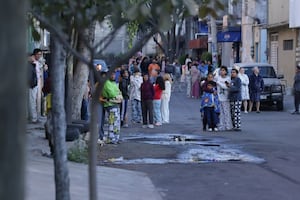Más Información

Capturan a “El Betillo” en Morelia; lo vinculan con asesinato de Hipólito Mora, fundador de las autodefensas michoacanas

Ernestina Godoy nombra a Ulises Lara, fiscal especial en Investigación de Asuntos Relevantes; "estaremos trabajando por la justicia"

Sismo en CDMX: “Nos sacó un susto porque se movió como gelatina”, relata empleado de estacionamiento público

Sheinbaum pide a Segob ampliar protección a periodistas tras caso de Rafael León; "por encima de todo está la libertad de expresión"
The Santa Lucia Airpot is being built over a land full of animal remains for 8,700 bones of 200 mammoths, 20 human bodies, 20 camels, 10 horses, and 2 bison have been found so far. Experts estimate that by the end of the project, they will have discovered a total of 25,000 mammoth bones.
Archeologist Rubén Manzanilla, who coordinates the archeological salvage team, explains that 40 of the 200 mammoths are almost complete, “they are cases that have 90% of the skeletons; nevertheless, due to the counting in other contexts that include bones like skulls, defenses, and pelvis, we’re speaking of 200 specimens and it must be clear that nota ll of them are complete.”
Manzanilla adds that the 200 mammoths are not located in the same perimeter, all together, but that they are scattered, although he mentions the site used to be a lake and the waves created places where the remains “gathered.”
It is there, in the piles of mammoth bones, where they have also found mixed remains of camels, horses, and bison. Nevertheless, the mammoths that died closer to the center of the lake are the ones that are almost complete.
Recommended:
In June, experts revealed they had found almost 70 mammoths, now, three months later, that have found 200, although Rubén Manzanilla and his archeological team expect to have found 25,000 mammoth bones of 10,000 years of age when the construction of the new building concludes.
“To date, we have found 8,700 bones; a number that will rise as works continue. We have estimated we’ll find 20,000 or 25,000 bones by the end of the works.”
From the 200 mammoths, nearly 40 are almost complete.
Along with the findings, archeologists have noticed that some mammoth remains could have been extracted by humans, such as the ones found at the traps in Tultepec, in 2019, although this is still being analyzed.

“To confirm this, we must perform prints tests which have yet to be done. For now, we must be careful.”
In addition to the mammoths, they have found over 20 camels, 10 horses, and “the most difficult to find have been bison.” They are pending to confirm the presence of saber-toothed tigers among the remains.
Recommended:
Regarding human remains, the archeologist said they have identified 20 bodies, 17 of which are almost complete; they are approximately 1,100 years old and must have belonged to the Coyotlatelolco culture.
Rubén Manzanilla remembers that at the beginning of the project, there were only six archeologists and now the team is comprised of 350 people – 41 archeologists, five restaurateurs, and 300 manual workers – that are coordinated so that each work done by the bulldozers is accompanied with supervisors to identify possible findings.
“So far, we are being an efficient team although not sufficient because the works are really huge. Luckily, there is good communication with the SEDENA and in case we needed more archeologists, it would be negotiated, as has happened since the beginning.”
Meanwhile, the mammoth remains are safeguarded in the future airport.
mp
Noticias según tus intereses
[Publicidad]
[Publicidad]










